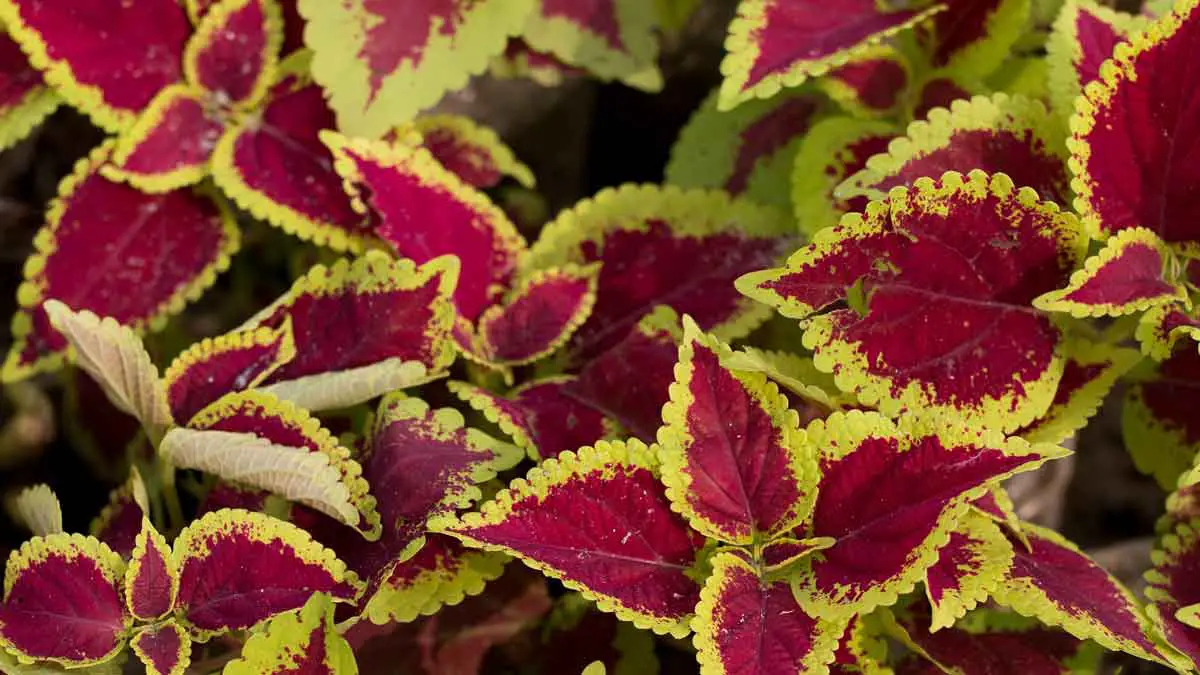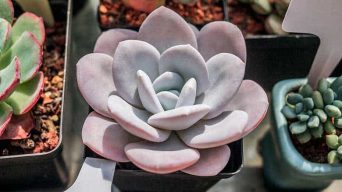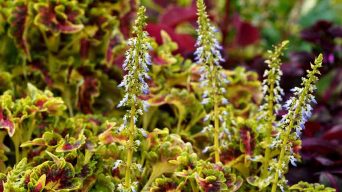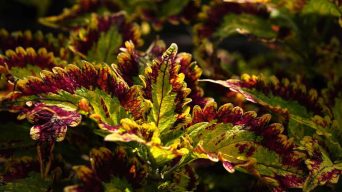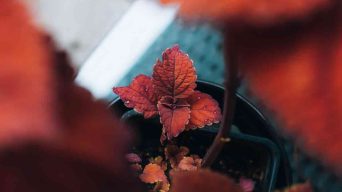To treat powdery mildew on coleus plants, mix 1 tablespoon baking soda and ½ tsp liquid soap in 1 gallon of water and spray on the affected areas. You can also use milk or neem oil. Regular pruning and removing infected parts can also help. Proper watering, sunlight, and plant spacing can prevent powdery mildew.
Coleus plants are popular houseplants with colorful foliage and bright flowers, making them an attractive addition to any home.
Unfortunately, they can become susceptible to powdery mildew if not properly cared for.
Powdery mildew is a fungal disease that causes white spots on the leaves of coleus plants and can be difficult to treat.
In this article, we’ll discuss how you can effectively treat powdery mildew on your coleus plant and keep it looking healthy and vibrant.
Common Symptoms of Powdery Mildew on Coleus Plants
The most common sign of powdery mildew on coleus plants is the appearance of white spots or patches on the leaves.
These spots are usually powdery and may spread throughout the entire plant if left untreated. The leaves may curl, wilt, and turn yellow, eventually causing stunted growth.
The coleus leaves may fall off prematurely in severe cases of powdery mildew on coleus plants.
How Does Powdery Mildew Spread
Powdery mildew spreads through airborne spores. In warm, dry weather, the spores are easily spread by wind.
Wet, humid conditions can also encourage the growth of powdery mildew and help spread the infection.
The spores then attach to the plant’s leaves and stem and grow into a white, powdery coating.
If left untreated, it can spread to other parts of the plant and nearby plants.
The spores can survive over winter and continue to spread infection when temperatures rise again in spring or summer.
It is important to carefully dispose of plant debris from infected plants to prevent powdery mildew from spreading.
Causes of Powdery Mildew on Coleus Plants
Powdery mildew is caused by a group of fungi that thrive in warm, humid environments but tend to spread more quickly in dry conditions.
The spores need a moist environment to grow and reproduce, so humid areas are more prone to powdery mildew outbreaks.
These fungi tend to attack the older leaves of the coleus plant, causing white spots and eventually killing off those leaves.
Identifying the cause of powdery mildew on your coleus is important before you begin treating it.
The most common causes of powdery mildew on coleus plants include:
- High Humidity Levels. High humidity levels encourage the growth of powdery mildew on coleus plants, especially if temperatures remain warm.
- Overwatering. Providing too much water to your coleus plant can also create the ideal environment for powdery mildew. The overwatered soil can become compacted and stagnant, encouraging spores to grow and spread quickly.
- Poor Air Circulation. Poor air circulation can also contribute to powdery mildew outbreaks, as it prevents airflow and stagnates the air around your plant, allowing spores to grow and spread more easily.
- Not Enough Sunlight. Low light levels can encourage the growth of powdery mildew on coleus plants. The plants need at least six hours of direct sunlight per day to stay healthy and prevent the growth of powdery mildew.
- Overcrowding. Overcrowding of plants can also encourage the spread of powdery mildew. Too many plants in a small space can create poor air circulation and trap moisture around the leaves, encouraging spores to grow and spread quickly.
How To Treat Powdery Mildew on Coleus Plants
Treating powdery mildew on coleus plants is not difficult if you catch it early.
The first step is to identify the cause of the problem and take measures to prevent it from happening again.
Once you have identified the source, you can start treating your plant.
Some of the most effective methods of treating powdery mildew on coleus plants include:
Baking Soda Solution
Making a baking soda solution is an effective way to treat powdery mildew on coleus plants.
Add 1 tablespoon of baking soda and 1/2 teaspoon of dish soap to one gallon of water.
Shake the mixture until it’s thoroughly mixed, and spray it directly onto the affected leaves.
This solution kills the fungus and helps prevent further outbreaks.
Neem Oil
Neem oil is a natural way to treat powdery mildew on coleus plants.
Mix 1-2 tablespoons of neem oil with 1 gallon of water and shake until it is thoroughly mixed. Spray directly onto affected leaves, and repeat every 7-14 days.
Neem oil works by killing the spores and preventing them from spreading further.
Potassium Bicarbonate Spray
Potassium bicarbonate is also an effective treatment for powdery mildew on coleus plants.
Make a solution of 2 teaspoons of potassium bicarbonate, 1 gallon of water, and 1/2 teaspoon of liquid soap.
Mix the solution well and spray it on your coleus plants every 7-10 days until the powdery mildew has cleared up.
Be sure to cover both sides of the leaves for maximum effect.
Milk Spray
Milk is a natural and effective way to treat powdery mildew on coleus plants.
Mix 1 part milk with 3 parts water, and spray it directly onto the affected leaves.
Repeat this treatment every 7-10 days until the powdery mildew has cleared up.
Make sure to cover the plant thoroughly, paying special attention to the undersides of the leaves.
For an extra boost, add a few drops of dish soap or neem oil to the mixture before spraying it onto the plant. This will help stick the solution to the leaves and improve its effectiveness.
Sulfur-containing Organic Fungicides
Another method to treat powdery mildew on coleus is by using sulfur-containing organic fungicides.
Sulfur-based products must be applied every 5 to 7 days while temperatures are below 90F and humidity levels are low.
When applying the product, it’s important to follow the directions and use protective clothing, such as a face mask, long-sleeved shirt, and gloves.
Sulfur-containing organic fungicides effectively treat powdery mildew on coleus plants but may cause leaf damage if applied too frequently or in high temperatures.
Pruning or Trimming of Affected Areas
One way to treat powdery mildew on the coleus is by pruning or trimming the affected areas. This removes the infected parts of the plant, making it healthier and better able to resist further infections.
Pruning should be done carefully, as removing too much may cause damage to the plant.
Dispose of the pruned material immediately, as it can spread the powdery mildew to other plants.
In extreme cases, the entire plant may need to be destroyed and discarded.
It’s important to disinfect the pruning shears or scissors with rubbing alcohol before and after pruning. This will prevent the spread of disease from one plant to another.
How To Prevent Powdery Mildew From Occurring on Coleus Plants
Prevention is key when it comes to powdery mildew on coleus plants.
Taking the following steps can help prevent this fungal disease from occurring:
- Plant your coleus in an area with good air circulation, as this helps reduce humidity levels and prevents the fungus from spreading.
- Water your plants from below rather than from above, as this keeps the leaves dry and reduces the chances of powdery mildew infection.
- Prune or trim off any diseased parts as soon as you spot them.
- Keep the area around your plants clean and free from debris, which can harbor fungal spores.
- Water your coleus in the morning to avoid overwatering.
- Thin out plants to improve airflow and reduce humidity levels.
- Space out your plants to prevent overcrowding and improve air circulation.
- Place coleus plants in an area that gets proper sunlight.
- Avoid excessive fertilizer use, as this can increase the risk of fungal infections.
- Remove any infected plants immediately and discard them.
- Disinfect your pruning shears or scissors before and after pruning.
Final Thoughts
Powdery mildew on coleus plants can be managed with proper plant care and treatment.
If caught early, the use of fungicides may not be necessary.
Regularly check your coleus for signs of infection and take action quickly if you spot any evidence of powdery mildew.
Use a combination of cultural control methods such as proper watering, pruning, and spacing of plants to reduce the spread of infection, and if needed, treat with a natural fungicide.
You can keep your coleus looking its best with the right combination of prevention and treatment strategies!

